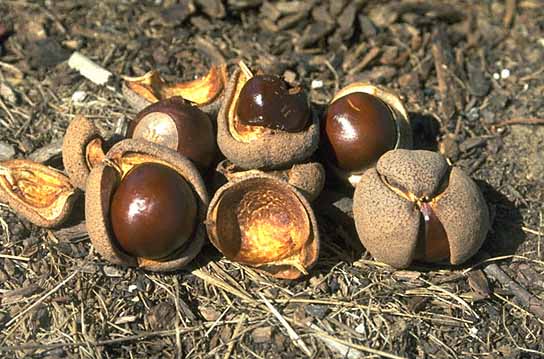|
|
|

Yellow Buckeye
(Aesculus octandra)
Description: Tree with rounded crown and upright clusters of showy yellow flowers.Height: 70-90' (21-27 m).
Diameter: 2-3' (0.6-0.9 m).
Leaves: opposite; palmately compound; with slender leafstalks 3 1/2-7" (9-18 cm) long. 5-7 leaflets 4-8" (10-20 cm) long, 1 1/2-3" (4-7.5 cm) wide; elliptical to obovate; evenly saw-toothed; short-stalked. Dark green and usually hairless above, yellow-green and often hairy beneath.
Bark: brown to gray; thin, fissured into large scaly plates.
Twigs: light brown; stout, often hairy.
Flowers: 1 1/4" (3 cm) long; with 4 very unequal yellow petals and 7-8 shorter stamens; in upright branched terminal clusters 4-6" (10-15 cm) long; in spring.
Fruit: 2-3" (5-7.5 cm) in diameter; a pale brown, smooth or slightly pitted capsule, splitting on 2-3 lines; 1-3 large shiny brown poisonous seeds; maturing in early autumn.
Habitat: Rich, moist, deep soils from river bottoms to deep mountain valleys or slopes; in mixed forests.
Range: Sw. Pennsylvania south to n. Alabama and n. Georgia and north to extreme s. Illinois; at 500-6300' (152-1920 m).
Discussion: The largest of the buckeyes, it is abundant in Great Smoky Mountains National Park. The seeds are poisonous, and young shoots are toxic to livestock. American Indians made a nutritious food from the seeds, after removing the toxic element by roasting and soaking them.